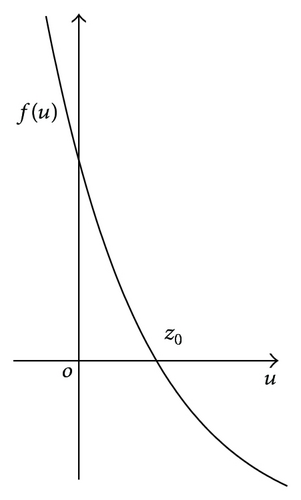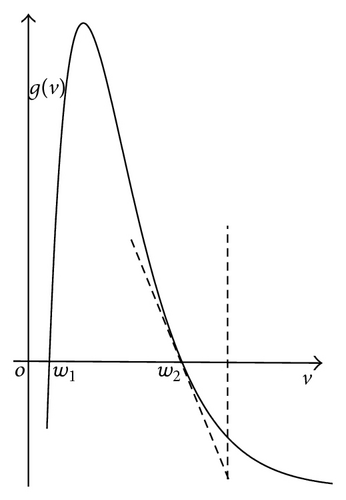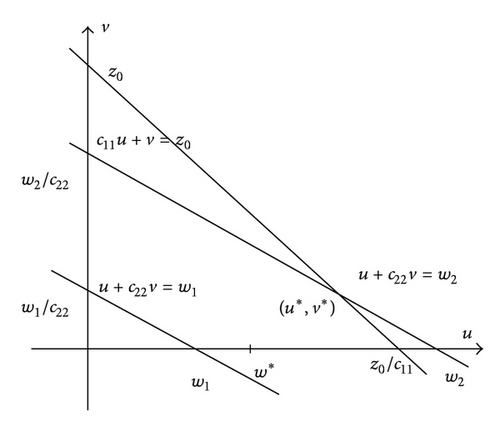Traveling Wavefronts of Competing Pioneer and Climax Model with Nonlocal Diffusion
Abstract
We study a competing pioneer-climax species model with nonlocal diffusion. By constructing a pair of upper-lower solutions and using the iterative technique, we establish the existence of traveling wavefronts connecting the pioneer-existence equilibrium and the coexistence equilibrium. We also discuss the asymptotic behavior of the wave tail for the traveling wavefronts as s = x + ct → −∞.
1. Introduction
As we know, the interactions among species are important in determining the process of evolution for the ecosystem, and the modeling accompanied with the mathematical analysis of the models can help people to understand and control the propagation of species. In general, the per capital growth rate (i.e., fitness) for a species in the model is assumed to be a function of a weighted total density of all interacting species. A well-known example is the standard Lotka-Volterra model; its fitness of a species is a linear function. It is natural to consider other kinds of fitness functions other than the linear one, because of the various species and interaction rules. In this paper, we will analyze a reaction-diffusion model describing pioneer and climax species. This model describes interaction among species with peculiar fitness functions.
A species is called a pioneer species if it thrives best at lower density but its fitness decreases monotonically with total population density for overcrowded. Thus, the fitness function of a pioneer species is assumed to be a decreasing function. Pine and yellow poplar are the species of this type. A species is called a climax species if its fitness increases up to a maximum value and then decreases of its total density. Hence, a climax population is assumed to have a nonmonotone, “one-humped” smooth fitness function. Oak and maple are the climax species.


There are some existing results about the stability and traveling wave solutions for (2) ([4–6]). About traveling wave solutions, Brown et al. [4] studied the traveling wave of (1) connecting two boundary equilibria by singular perturbation technique, and Yuan and Zou [6] obtained the existence of traveling wave solutions connecting a monoculture state and a coexistence state by upper-lower solution method combined with the Schauder fixed point theorem. Also see van Vuuren [7] for the existence of traveling plane waves in a general class of competition-diffusion systems and Murray [8] for more biological description of traveling wave solutions.
Although the Laplacian operator Δ : = ∂2/∂x2 is always used to model the diffusion of the species, it suggests that the population at the location x can only be influenced by the variation of the population near x. As we know that the individuals can move freely, then the movement of individuals is bounded to affect the other individuals. So, the Laplacian operator may have some shortage to describe the diffusion. One way to deal with this problem is to replace the Laplacian operator with a convolution diffusion term This implies that the probability distribution function for the population at location y moving to the location x is J(x − y). At time t, the total individuals that move from the whole space into the location x will be . Therefore, one may call it as a nonlocal diffusion, and, correspondingly, call ∂2u(t, x)/∂x2 as a local diffusion. During the recent years, the models with the nonlocal diffusion have been attracted much more attentions (see [15–18]).
We are interested in traveling wavefronts accounting for a mildinvasion of the two species (traveling wavefronts connecting a boundary equilibrium and the coexistence equilibrium). For system (2), the sufficient condition for (2) to have a mildinvasion is d2/d1 ≥ 1/2 (see [6]), but our condition in this paper for system (6) is d2/d1 ≥ 1, which reveals a fact that the nonlocal diffusion of either the pioneer species or the climax species did affect the climax invasion and wave propagation. Please see Section 5 for the discussion.
The remaining of this paper is organized as follows. In Section 2, there are some preliminaries about the equilibria and the system is transformed into a cooperative one. In Section 3, we prove the existence of traveling wavefronts by using an iteration scheme combined with a pair of admissible upper and lower solutions, which can be constructed obviously, and thus a criterion of the existence for traveling wavefronts is obtained. We also give a discussion on asymptotic behavior for the traveling wavefront tail as s = x + ct → −∞ in Section 4. At last, we give some concluding discussions in Section 5.
2. Preliminaries

As mentioned in the introduction, we are interested in the coexistence of the two species. That means that we will seek traveling wavefronts connecting equilibrium (z0/c11, 0) and equilibrium (u*, v*).
3. Existence of Traveling Wavefronts
A traveling wavefront of (6) connecting equilibria (z0/c11, 0) and (u*, v*) can be changed into a traveling wavefront of (11) connecting (0,0) and (u+, v+). Therefore, we consider the system (11) hereby.
The following lemma states the monotone property of H.
Lemma 1. Assume that (A1) holds, for sufficiently large β1, β2 > 0 and (ϕi, φi) ∈ 𝔻, i = 1,2 with ϕ1(s) ≤ ϕ2(s) and φ1(s) ≤ φ2(s), s ∈ ℝ; one has
- (i)
H1(ϕ2, φ1)(t) ≥ H1(ϕ1, φ1)(t),
-
H2(ϕ1, φ2)(t) ≥ H2(ϕ1, φ1)(t),
- (ii)
H1(ϕ1, φ2)(t) ≥ H1(ϕ1, φ1)(t),
-
H2(ϕ2, φ1)(t) ≥ H2(ϕ1, φ1)(t)
Proof. In order to prove (i), let f1(x, y) = (x − z0/c11)f(z0 − c11x + y) + b1x, g1(x, y) = yg(z0/c11 − x + c22y) + b2y. Then
For (ii), we know that 0 ≤ ϕ1(t) ≤ u+ = z0/c11 − u* ≤ z0/c11 and f′(y) < 0 for y ∈ ℝ. It follows that
The conclusion of the following lemma is direct.
Lemma 2. Assume that β1 > 0, β2 > 0 are sufficiently large. For (ϕ, φ) ∈ 𝔻 with ϕ(t), φ(t) nondecreasing on t ∈ ℝ, H1(ϕ, φ)(t), H2(ϕ, φ)(t) are also nondecreasing on t ∈ ℝ.
We can easily see that Q = (Q1, Q2) also enjoys the same properties as those for H = (H1, H2) settled in Lemmas 1 and 2.
Definition 3. A pair of continuous functions , is called an upper solution and a lower solution of (12), respectively, if there exists a set Γ = {Ti ∈ ℝ, i = 1, …, k} such that and are differentiable in ℝ∖Γ and the essential bounded functions satisfy
- (P1)
for t ∈ ℝ;
- (P2)
, ;
- (P3)
and are nondecreasing.
Lemma 4. For n ≥ 2, the functions , and , defined by (26) satisfy
- (i)
;
- (ii)
for t ∈ ℝ;
- (iii)
and is a pair of upper and lower solutions of (12);
- (iv)
and are continuously differentiable on t ∈ ℝ.
Proof. We only give the argument for n = 2, and the situation for n ≥ 3 can be obtained by mathematical induction. From Definition 3, we obtain
By similar arguments, we can get
From the monotone property of Q, we can easily obtain that , are nondecreasing for t ∈ ℝ, and therefore the conclusion (i) holds.
For , by Lemma 1, we have
The conclusion (iv) is obvious. The proof is complete.
Lemma 5. , and the convergence is uniform with respect to the decay norm |·|μ.
Proof. We have from Lemma 4 that the following limit exists:
Since
From the previous estimates, we know that is equicontinuous on [−T, T] with respect to the supremum norm. On the other hand, we have from Lemma 4 (ii) that is uniformly bounded. By Arzéla-Ascoli theorem, there exist subsequences of which are uniformly convergent in t ∈ [−T, T]. Without loss of generality, we still express this subsequence as . Thus, there exists a positive integer N* > 2, such that
Summarizing the previous arguments, for n > N* we have
Theorem 6. Assume that (A1) holds; if (12) has a pair of upper and lower solutions that satisfy (P1)–(P3), then the system (11) has a traveling wavefront satisfying (13).
Proof. By the Lebesgue′s dominated convergence theorem and the iteration scheme (26), we have
Lemma 7. The following conclusions are true.
- (i)
There exists a (λ*, c*), λ* > 0, c* > 0 such that
() - (ii)
For 0 < c < c*, F(λ, c) > 0 for λ ∈ ℝ.
- (iii)
For c > c*, the equation F(λ, c) = 0 has two zeros 0 < λ1 < λ2 such that
()
Now we are ready to construct the upper solution of (12).
Proof. Let t1, t2 be such that
If t < t0, , , we have from the fact for t ∈ ℝ and w1 < w* ≤ u* < z0/c11 < w2 that
If t > t0, , , we have
Lemma 9. Define
Proof. Let t3 be such that , it follows that
If t < t3 < 0, , , and for t ∈ ℝ, we have
Let By the fact that
If t > t3, , , and for t ∈ ℝ, we have
From the previous arguments, we obtain that is a lower solution of (12). By Lemma 4, we can get that is also a lower solution. Furthermore, for t < t3, , by direct calculation, we have for t < t3. Therefore, for t ∈ ℝ. Similarly, we have for t ∈ ℝ. The proof is complete.
Theorem 10. Assume that (A1) and d2 ≥ d1 hold. Then for any c ≥ c*, the system (11) has a traveling wavefront with speed c, which connects (0,0) and (u+, v+).
Proof. The conclusion for c > c* can be obtained from the previous discussions. We only need to establish the existence of wave fronts when c = c*.
Let ck ⊂ (c*, c* + 1) with lim k→∞ ck = c*. For ck > c*, (12) with c = ck admits a nondecreasing solution (ϕk(t), φk(t)) such that
As the same argument in Lemma 5, we can obtain that {(ϕk(t), φk(t))} is uniformly bounded and equicontinuous on ℝ; using Arzéla-Ascoli theorem and the standard diagonal method, we can obtain a subsequence of {(ϕk(t), φk(t))}, still denoted by {(ϕk(t), φk(t))}, such that (ϕk(t), φk(t)) → (ϕ*(t), φ*(t)) uniformly for t in any bounded subset of ℝ, as k → ∞. Clearly, (ϕ*(t), φ*(t)) is nondecreasing and (ϕ*(0), φ*(0)) = (u+/2, v+/2).
By the dominated convergence theorem and (67), it follows that
Remark 11. We say that the c* is the minimal wave speed in the sense that (11) has no traveling wavefront with c ∈ (0, c*). We could briefly explain this in the following. In fact, the linearization of (12) at zero solution is (41), and the function F(λ, c) is obtained by substituting eλt in the second equation of (41). For 0 < c < c*, we know from (ii) of Lemma 7 that F(λ, c) > 0 for any λ ∈ ℝ. We have from the second equation of (12) and the second equation of (41) that (12) cannot have a solution (ϕ(t), φ(t)) that satisfies lim t→−∞ (ϕ(t), φ(t)) = (0,0).
4. Asymptotic Behavior for Traveling Wavefronts
In this section, we discuss the asymptotic behavior for the traveling wavefronts obtained in the previous section as t → −∞.
Theorem 13. Let (ϕ(t), ψ(t)) be a traveling wavefront of (11) decided by Theorem 10; then
Proof. Note that
Note that we have from and (A1) that
Now, letting (ζ(t), ς(t)) be a traveling wavefront of (6) decided by Theorem 12, by the equivalence between (6) and (11), we know that (ζ(t), ς(t)) = (z0/c11 − ϕ(t), φ(t)) and thus obtain the following theorem.
5. Concluding Discussions
We have considered a reaction model with nonlocal diffusion for competing pioneer-climax species. Some recent works (see Brown et al. [4], Yuan and Zou [6]) showed that the model with local diffusion (expressed by Laplacian operator) supports traveling wavefronts connecting two boundary equilibria or one boundary equilibrium and the coexisting equilibrium under some restrictions on the parameters. In Yuan and Zou [6], the sufficient condition for (2) to have the traveling wavefront connecting (z0/c11, 0) and (u*, v*) is d2/d1 ≥ 1/2, but ours for (6) with nonlocal diffusion is d2/d1 ≥ 1. For a fixed d2, to shift d2/d1 ≥ 1/2 to d2/d1 ≥ 1, one needs a smaller d1. But for a fixed d1, to shift d2/d1 ≥ 1/2 to d2/d1 ≥ 1, one needs a larger d2. These facts imply that the nonlocal diffusion of the pioneer species accelerates the mild wave propagation, while the nonlocal diffusion of the climax species defers the mild wave propagation. That is to say, the nonlocal diffusion did affect the wave propagation of these two competitive species.
We believe that this is the first time that the dynamics of the pioneer-climax competition model with nonlocal diffusion are studied. This model has complicated equilibrium structure, and we only considered one possible case about the traveling wavefront connecting one boundary equilibrium and the coexisting equilibrium. Some other situations about the species invasions and propagation of waves would be of great interest for further research.
Acknowledgments
The authors are very grateful to the anonymous referees for careful reading and helpful suggestions which led to an improvement of their original paper. Research is supported by the Natural Science Foundation of China (11171120), the Doctoral Program of Higher Education of China (20094407110001), and the Natural Science Foundation of Guangdong Province (10151063101000003).




